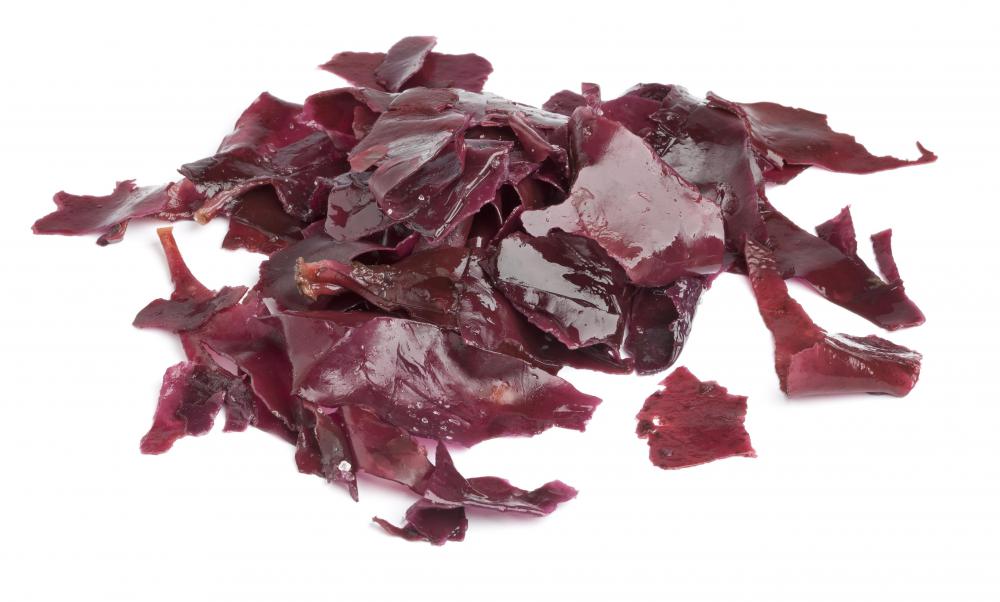At AllThingsNature, we're committed to delivering accurate, trustworthy information. Our expert-authored content is rigorously fact-checked and sourced from credible authorities. Discover how we uphold the highest standards in providing you with reliable knowledge.
What is Marine Algae?
Many people are familiar with marine algae as common seaweed. It is a multicellular organism and includes both green and brown varieties of algae, as well as red marine algae. The plant is considered the oldest organism in the plant kingdom. Some varieties of seaweed that people may be most familiar with include kelp, phytoplankton, and gulfweed.
Unlike the weeds found among garden plants, seaweeds do not consist of typical flowers, roots, or other plant parts. Though it contains chlorophyll, marine algae reproduces through spores. The size of seaweed can vastly vary. Some samples may be microscopic while others can be hundreds of feet or meters long, as many people with oceanic experience may attest to witnessing.
The majority of marine algae are red varieties, which make up 6,000 species of organisms. Brown algae accounts for another 2,000 species. Green varieties include 1,200 species of the seaweed.

Several countries, such as Japan, regularly use marine algae as a nutrition source. It was considered a delicacy in ancient China. Seaweeds are complete proteins, high in both carbohydrates as well as fatty acids, such as omega-3s. Red algae in particular is also considered an excellent source of vitamins and minerals. Many people in Western nations recognize these benefits and actively campaigned for a more widespread use of seaweed as a sustainable protein source.

Seaweed extractions are another benefit humans receive from the organism. Ingredients used in cooking, such as agar, are extracted from seaweed. Carrageenans extracted from red seaweeds are a popular ingredient in vegan alternative foods, such as gelatin. Cosmetic companies sometimes employ the use of seaweed extracts, as do insecticide manufacturers.

In addition to being used as a food source, seaweed is a popular base for several medicines. People take it as a nutritional supplement for an immunity boost and treating herpes. Some manufacturers claim that seaweed can help support weight loss; hence, many consumers purchase it for this reason as well.
Marine algae has some more surprising uses as well, including employing it as a fuel, livestock feed, or as fertilizer. Some farmers note, however, that when laying hens are fed a diet including marine algae, their yolks may exhibit discoloration. Seaweed is also used as a stabilizer in many products, such as ice cream and milkshakes.

Some types of marine algae are considered a nuisance. Fish tank owners, for example, often take special care to ensure that their tanks do not become overgrown with the organism. This can be done by feeding marine animals properly, installing a quality water purification system, and including organisms that feed on the algae in the tank.
Frequently Asked Questions
What exactly is marine algae and where can it be found?
Marine algae are a diverse group of photosynthetic organisms that inhabit the world's oceans, seas, and coastal areas. They range from microscopic phytoplankton to large seaweeds, like kelp. These organisms play a crucial role in aquatic ecosystems, producing oxygen and serving as a foundational element of the marine food web.
How important are marine algae to the ocean ecosystem?
Marine algae are vital to ocean health. They generate a significant portion of the Earth's oxygen; in fact, phytoplankton alone contribute up to 50% of the global oxygen production. Algae are also primary producers, forming the base of the marine food chain and supporting a vast array of wildlife, from tiny zooplankton to large marine mammals.
Can marine algae affect the Earth's climate?
Yes, marine algae significantly influence the Earth's climate. They absorb carbon dioxide during photosynthesis, which helps regulate atmospheric CO2 levels. This process not only mitigates the greenhouse effect but also impacts global carbon cycles. Algal blooms can also affect local weather patterns and ocean temperatures.
What are the different types of marine algae?
Marine algae are categorized mainly into three types: green, red, and brown algae. Green algae are similar to land plants in their chlorophyll content. Red algae, which contain phycoerythrin, thrive at greater depths. Brown algae, including many seaweeds like kelp, are typically larger and found in colder waters along rocky coasts.
How do humans use marine algae?
Humans have found numerous uses for marine algae. They are harvested for food, with species like nori and kelp being popular in various cuisines. Algae are also used in the production of fertilizers, animal feed, and biofuels. Additionally, they are a source of thickening agents and stabilizers in the cosmetic and pharmaceutical industries.
Are marine algae under threat from environmental changes?
Marine algae face threats from climate change, ocean acidification, pollution, and overharvesting. Rising sea temperatures can disrupt algal growth and distribution, while acidification affects their calcification processes. Pollution, such as oil spills and nutrient runoff, can lead to harmful algal blooms that deplete oxygen in the water and harm marine life.
AS FEATURED ON:
AS FEATURED ON:














Discuss this Article
Post your comments